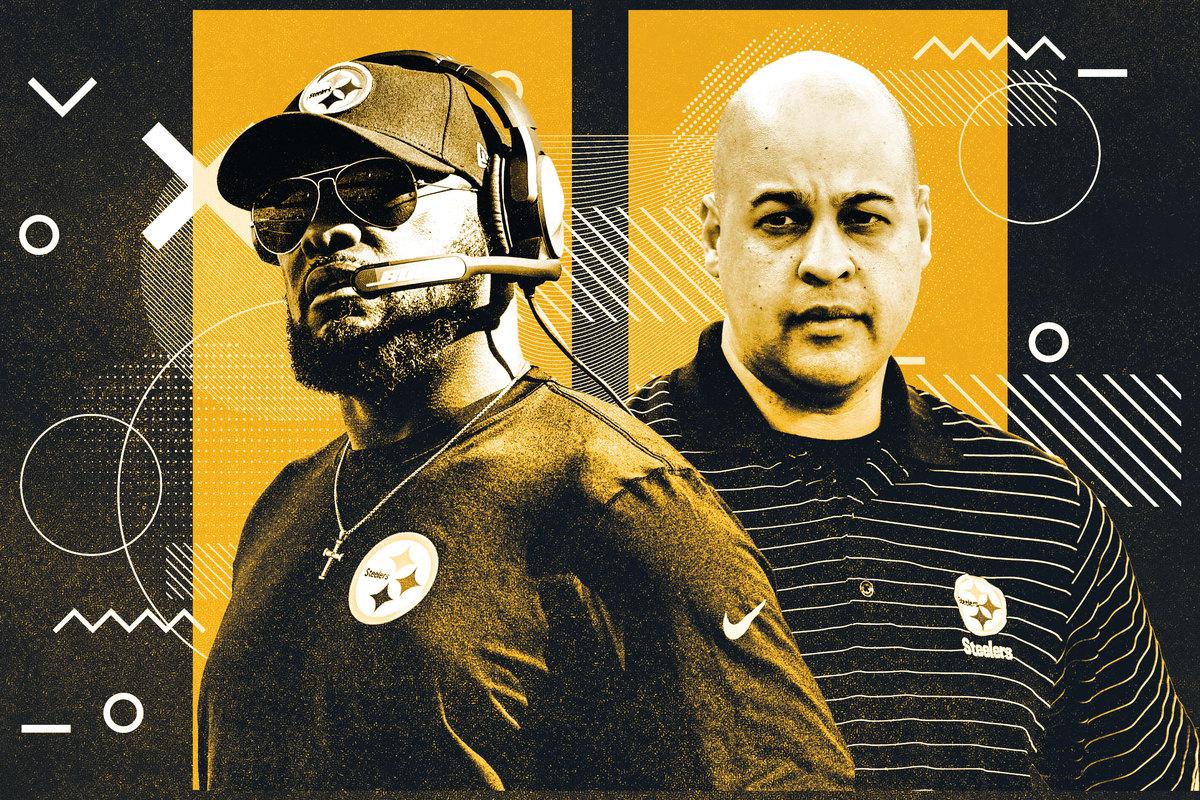
NFL teams have spent the past six months reshaping their rosters and now, finally, the 2022 regular season is nearly upon us. But which teams have truly pushed all their pieces to the middle of the table and are ready to make a serious run to Super Bowl LVII? Welcome to The Ringer’s All In Week, where we’ll examine the quarterback moves, team-building philosophies, and gambles that teams have made to compete for a championship and determine what it truly means to be all in.
The best quote I’ve heard about football this year came on The Pivot Podcast. A June episode featured Mike Tomlin, who has never had a losing season as Pittsburgh Steelers head coach despite years featuring one or all of the following: backup quarterbacks, an aging Ben Roethlisberger, star player contract disputes, a ludicrous injury list, the improvement of AFC rivals, and [gestures broadly] Antonio Brown. “I love to hear coaches resist the responsibility of coaching,” Tomlin began sarcastically, “that talk negatively about a dude that can’t learn. Man, if everybody could learn, we’d need less coaches. If the group didn’t need management, then we wouldn’t make as much.”
Tomlin went on to say he gets frustrated when he reads draft evaluations that say things like a player has poor hand usage. Well, that’s just coaching. Fix it. “I don’t run away from coaching. I run to coaching,” he said. “It’s all in line with not seeking comfort, because when you are a coach and you’re talking about somebody that can’t learn, you’re seeking comfort because your teaching is struggling.”
The sentiment helps explain why the Steelers are always good—and especially why they’re often better than they should be. In a league that features far more laziness than you’d think, very few staffs maximize and develop talent like Pittsburgh. When my editors asked me what I wanted to write for The Ringer’s All In Week—which looks at NFL roster construction and how and why teams decide to borrow from tomorrow to try to win today—I didn’t want to look at the Rams or Broncos or Raiders, teams that eschewed first-round picks in favor of instant success. I wanted to talk about a team that is always competing, but doing so in an extremely different way.
The Steelers do not push their chips into the middle of the table or try to bet their watch once they’ve lost their money. They don’t tear the roster down to the studs in favor of a long-term rebuild and hope for improved job security. They just … win.
“Stability is something that we appreciate and respect, but it’s not something that we take for granted,” Tomlin told me at Steelers training camp last month. “We don’t get stability just because we’re Steelers. We realize stability is created by doing acceptable work over an extended period of time. And so we focus our energies on the work that needs to be done in order to create it.”
In Pittsburgh, jobs almost never change over. The Steelers have had the same coach since 2007—Tomlin was hired in the same NFL coaching cycle as Bobby Petrino. They’ve had just three head coaches total since 1969. They had the same starting quarterback from 2004 until the end of last season. Former general manager Kevin Colbert was the first person in the organization’s history to ever officially have that title, and he held it from 2000 through the most recent draft. The turnover the team is seeing at quarterback this year—where veteran Mitchell Trubisky and first-round pick Kenny Pickett are battling for the starting spot—and general manager, where longtime NFL executive Omar Khan took over this spring, is normal in many other places. But it’s astounding by Steelers standards.
“Go back to the ’60s, and there was a level of instability,” defensive lineman Cameron Heyward said of the organization. But starting in 1969, with Chuck Noll, momentum built and never stopped: “Keeping those [coaches and players] around, that created success and it just kept trickling to the next group, and the next group. Having coaches like Noll and [Bill] Cowher and Tomlin, that breeds success. You look at [the transition] from Kevin to Omar, and we’re hoping for the same thing.”
Colbert left Pittsburgh in May after 21 years, countless star wide receivers taken in the middle rounds, and two Super Bowl wins. And following an exhaustive interview process, the Steelers tabbed Khan to take over the role later that month. Khan left the meeting where he’d gotten the good news and called his wife, who was thrilled; he called his parents, who’d heard him talk about this day for decades; and then he told his young daughters, who didn’t understand what was going on. One of them had had a dance recital that day and they just spent the rest of the night talking about that.
Khan has wanted to be a GM since he was a kid for a simple reason: He grew up as a fan of some really bad Saints teams. Born in New Orleans in 1977, Khan did not see a winning Saints season until he was 10 years old (they didn’t have one the 10 years before his birth, either). But in 1987, things changed. “A man named Jim Finks started to turn things around,” Khan said of the Saints GM in the late 1980s. “I remember how excited I was to watch the Saints make it to their first playoff appearance, to watch Jim Finks work.” The 1987 Saints went 12-3, and to start the 1990s, the team had three straight playoff appearances.
Khan wanted to bring that kind of excitement to people. But he’s doing so now for a franchise that is more or less the exact opposite of the one he fell in love with as a kid: a team that competes every year. A team where expectations never wane, and no one is afraid to talk about them, even during what most would consider a transition year.
After moving from a football operations role with the Saints to a cap-related position with Pittsburgh in 2001 (in his last year in New Orleans, he worked with the coaching staff and became close with then-assistant Mike McCarthy), Khan quickly learned, “Everything we do is about building [to] a Super Bowl championship.” Khan said he looks at every move in a four-year window, and wants to understand the ripple effect each will have on the future—but to quote another Tomlinism: The standard is the standard. “We’re trying to compete every single year and win the Super Bowl every single year,” Khan said. “We are not going to put ourselves in a position where we’re not. That’s the goal every single year.” That means no roster teardowns, no top-five picks after taking a year off. Throughout the 18 years of the Roethlisberger era, the Steelers made one top-10 pick, and it was a trade-up.
Everything is more expensive when you’re trying to win a Super Bowl. Kyle Shanahan once said that only five teams are actually trying to win the Super Bowl every year, and the rest are just trying to survive. A franchise whose yearly stated goal is to win the Super Bowl is rare—but, so too, are the Steelers. Khan said the top trait he looks for while scouting staff and players is a love of winning. Everything else comes after. “The big thing I learned,” Khan said of conversations with both Colbert and Steelers owner Art Rooney II, “is don’t panic. Mr. Rooney says the same thing to me all the time: don’t panic.”
Khan’s primary focus for much of his Steelers career was the salary cap. I’ve previously written that data suggests cap experts are underappreciated as GM candidates, and I asked Khan what he thinks a cap person brings to the role. “Obviously the cap is just one part of it, but it brings the knowledge of that, and as the money continues to grow, it’s a bigger part of this,” he said. The money does continue to grow: The NFL salary cap spiked more than $25 million between 2021 and 2022, and that’s only expected to increase. The Steelers will not have to spend big on a quarterback over the next few years (“I’d say that gives you an opportunity maybe to address other positions to take the pressure off,” Khan told me) and that gives them cap flexibility even with a handful of second-contract stars. Still, more talent acquisition is likely needed if this team is going to compete in an increasingly scary AFC. My colleague Warren Sharp’s football preview guide ranks the Steelers quarterbacks 29th in the league, the offensive line 30th, and two other groups—pass catchers and secondary—20th or worse.
There are a lot of directions the Steelers can go from here. Pittsburgh is spending the least on offense in the NFL this year at $65 million, according to Over the Cap, and the most on defense at $123 million. This doesn’t necessarily correlate with quality—the Commanders are the NFL’s most expensive offense and the Lions are second, partly because of the second-contract quarterbacks they took on in trades. But it’s a snapshot of where the Steelers’ pricey, talented veterans are. And there are mixed messages even within that defensive unit. According to Pro Football Focus, only three players in that group ranked among the top 50 in their positions last season. But two of them—Heyward and T.J. Watt—are unquestioned superstars who can wreck a play or a game. Add this with Tomlin’s ability to annually make the team better than the sum of its parts, and it means they could have something.
I went to two Steelers practices this summer and saw what are probably the dominant themes of camp: Rookie receiver George Pickens was the best player on the field and looked like he was going to have an instant impact. And the quarterbacks looked like they might struggle to help him do that. Neither Pickett nor Trubisky particularly impressed me, though Pickett has shown far more in preseason games than he did when I was there. And someone smart with the Bills told me they think Trubisky will be worlds better than he was in Chicago—this is not a particularly high bar to clear—because he got too robotic as Bears quarterback and spending a year with Josh Allen, Ken Dorsey, and Brian Daboll helped him play looser and, by extension, faster. This does not mean that Trubisky will be the new Patrick Mahomes, just that he’ll be better than Chicago Mitch. I asked Heyward what’s different about a quarterback battle in the epitome of stability.
“There are a lot of players around them that can play, that can alleviate a lot of the stress,” Heyward explained. “Let’s not toot our own horn, but I think providing a good defense should help. A good running game, receivers, tight ends. You have to take advantage of that. That should separate you. There’s a level of the group where you should be insulated and be able to work through your mistakes.”
There’s some debate over how much of a chance Pickett has to begin this season as QB1. Fox’s Jay Glazer said last week that there wasn’t a quarterback controversy, and that Trubisky would be the starter. ESPN’s Adam Schefter thinks Pickett will start “at some point” during the season. “Essentially, as soon as Mitchell Trubisky has a stumble, early in the season, that will open the door to get to Kenny Pickett.”
As for Khan, though, Heyward said the path forward is simple. “The main thing is just being stable,” Heyward said. “We’re not looking for the big splash here.”
